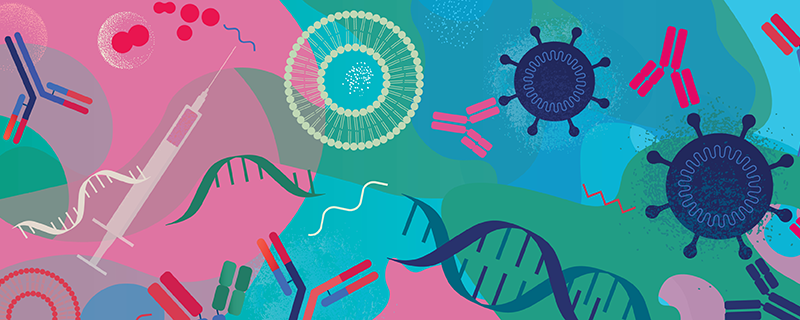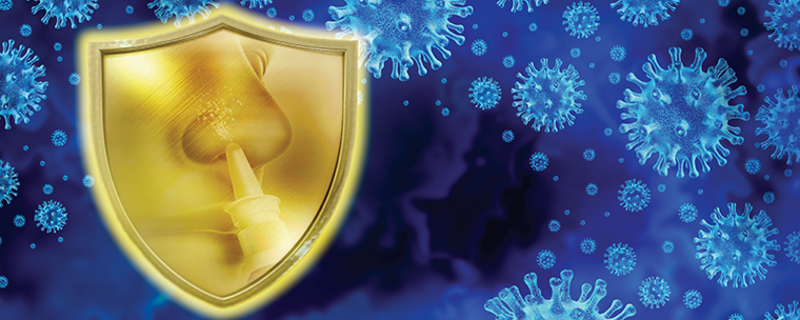Breadcrumb
- Home
- Spring 2023
Spring 2023
Leadership Corner: It Isn't Over

Hospitalizations Decrease, Research Continues, and Many Remain at Risk
The Clinical and Translational Serology Task Force continues to hold regular meetings with stakeholders from academia, industry, and government to present and discuss the latest findings and technology advancements in COVID-19 serology and vaccines. On January 17, CTTF hosted its first workshop, titled SARS-CoV-2 Mucosal Immunity: Methodological Considerations and Best Practices Workshop, which gathered over 160 participants to review the status of mucosal assay development and standardization, discuss gaps, and outline priorities to facilitate both an understanding of mucosal immune responses and the development of new mucosal vaccines.
Life seems to be returning to normal, as COVID-19-related hospitalizations and the number of people in intensive care units have continued to decline since November 2022. Community transmission in the U.S. is also improving but still relatively high, with daily deaths above 400. The elderly, the immunocompromised, and people with a serious underlying illness, such as heart disease, lung disease, or diabetes, are among the most affected. Most of us now have hybrid immunity, a combination of immunity from vaccines and natural infection, but this immunity wanes over time. The U.S. Centers for Disease Control and Prevention continues to urge everyone to get the bivalent booster, as vaccination remains the best tool to stay protected.
We look forward to continued engagement and discussion as we all move through the different phases of this pandemic. We welcome your suggestions, comments, and requests, and we’re looking forward to working with and hearing from all of you.

Director, Vaccine, Immunity, and Cancer Directorate
Frederick National Laboratory for Cancer Research

Associate Director, Research Technologies, DIR, NIAID
Scientific Program Director, CSSI, OD, NCI
Contracting Officer Representative, CSSI, OD, NCI

Professor and Chairman for the Mount Sinai
Health System Department of Pathology

Acting Director
National Cancer Institute
Right Under Our Noses

Using Mucosal Vaccines to Stop SARS-CoV-2 Transmission
More than 13 billion doses of injectable COVID-19 vaccines have been administered to people worldwide since late 2020. Within the first year of vaccine rollout, COVID-19 hospitalization rates and deaths dropped dramatically.
However, this immunity waned, particularly upon the appearance of the Omicron variant, with its ability to rapidly produce subvariants that evade immunity gained from vaccination and natural infection with earlier variants. Breakthrough infections are increasingly common. People have caught COVID-19 again and again, and transmission has increased as protective behaviors have relaxed.
We need a new approach to rein in SARS-CoV-2 infection and transmission.
Current COVID-19 vaccines are very effective at protecting against disease severe enough to require hospitalization, but they are not especially effective at blocking SARS-CoV-2 infection or transmission. They are injected intramuscularly and produce antibodies that are detectable in the bloodstream, but they don’t produce a significant mucosal neutralizing antibody response at mucosal sites, such as the nose and mouth, where the virus first infects.
These findings highlight the necessity of developing other strategies to establish better antiviral mucosal immunity and, fortunately, options are already under investigation.
Mucosal vaccines—administered directly to these mucosal sites—may stimulate the immune system to generate neutralizing antibodies against SARS-CoV-2. The goal is to create sterilizing immunity, the elimination of the virus at the mucosal surface so that it doesn’t invade the cells to cause disease or linger in the upper airway to be spread to others.
Prime Targets
Nasal immunity plays an important role in SARS-CoV-2 infection. The virus uses the ACE2 protein on host cells to invade them. Though found on multiple tissue types, ACE2 is especially abundant on the cells of the respiratory tract.
Omicron’s successful subvariants exhibit a wide range of mutations in their spike proteins. Spike binds to ACE2 proteins on host cells, which allows the virus to enter the cells and begin an infection. Spike is also the same protein that the intramuscular vaccines induce antibodies against.
Nasal or oral vaccines are believed to stimulate a protective mucosal immune response locally at the sites of infection, helping to fight off infection before it starts.
All of this makes the nose and mouth attractive sites for vaccination. However, a great deal of research remains to be done, from developing standardized methods to collect samples and measure immunity at the local level in nasal and oral fluids to deepening our understanding of the nuances of mucosal protective immunity.
In the Works
But it’s not unreasonable to be optimistic about the future of mucosal SARS-CoV-2 vaccines.
There are a few successful mucosal vaccines already in use against other viruses, including a live attenuated influenza vaccine (FluMist®) and a live attenuated polio vaccine. A live attenuated, intranasal vaccine for respiratory syncytial virus is in clinical trials now.
Similarly, multiple nasal and oral SARS-CoV-2 vaccine research efforts are underway. Researchers are using an array of viral vectors to immunize individuals against SARS-CoV-2 antigens. One approach uses an adenovirus carrying the gene for the SARS-CoV-2 spike protein. The adenovirus acts as a vector to get the spike gene into the host cells. This intranasal vaccine protected mice and nonhuman primates from infection. The results of a phase 3 human clinical trial in India were recently pre-printed, and the vaccine was recently approved for emergency use there.
In Canada, a new, potential inhaled COVID-19 vaccine (just entering phase 2 human trials this year) uses adenoviruses as vectors, as well as different SARS-CoV-2 antigens to broaden the recipient’s immune response. This approach is intended to help the vaccine convey protection against future SARS-CoV-2 strains with new mutations in their spike proteins.
The Newcastle disease virus (NDV), which normally infects poultry and is benign to humans, is another virus that has been used to develop an intranasal COVID-19 vaccine. Researchers used NDV as a vector to introduce a stabilized SARS-CoV-2 spike protein into host cells to induce an immune response. Animal study results showed that the mucosal vaccine protected animals from infection. Recently published, non-peer-reviewed results from an early-phase human clinical trial in Mexico showed that the vaccine was safe and could stimulate antibodies.
As an added advantage, this NDV-based vaccine is easy to produce in facilities set up to make influenza vaccines around the world, increasing its accessibility and lowering production costs.
A new strategy, called “Prime and Spike” by the research team that created it, uses a divergent spike-protein-subunit-based nasal spray as a booster to create mucosal immunity in mice that had received an mRNA-based vaccine. Results from this study have been pre-published without peer review.
More than 100 additional oral and nasal SARS-CoV-2 vaccine candidates are in various stages of testing.
More results are expected this year. If, like the early clinical trials above, the vaccines continue to prove safe—and demonstrate effectiveness—mucosal vaccines may assume an important role in our efforts to stop SARS-CoV-2 in its tracks.
No Ambivalence for Bivalence

COVID boosters are the key to prevent hospitalizations and death
Almost three years after COVID-19 became a household term, it continues to be in the headlines. And the situation is only getting more complicated.
The rapid development and deployment of the initial vaccines and subsequent bivalent boosters has significantly reduced the number of deaths and hospitalizations caused by SARS-CoV-2. But the situation remains highly fluid due to a stream of viral mutations that continue to threaten COVID-19 community levels.
As we have seen since 2020, the virus replicates rapidly and will likely continue to mutate. Although existing vaccines cannot completely block infection, they are extremely effective at preventing serious illness and thus, hospitalization, especially in those who are generally healthy and do not have compromised immune systems.
As of February 2023, the Omicron subvariant XBB1.5 (which first appeared in November 2022) is now the most common variant in the United States. It is also possibly the most transmissible.
The challenge for public health officials continues to be the very low uptake rate of the bivalent boosters. The CDC reports that only 16.5 percent of those age 5 and older who are eligible have gotten their bivalent booster. This pales in comparison to the nearly 70 percent of the population who completed their initial vaccinations.
What makes the low booster uptake even more troubling is the fact that experts estimate that exposure rates are much higher than many realize. The CDC reports significant under-reporting of infections. This is linked in part to a number of factors, including the availability of at-home testing, the lack of infrastructure to easily upload and report testing results and infections, a lack of concerning symptoms causing those with infections not to seeking medical care, or unidentified infections.
Complicating matters even further are low testing levels. Current infection data are largely based on cases that have been confirmed through medical sites and/or are serious enough for hospitalization. Among public health experts, there’s a debate over what COVID-19 numbers really reflect, but there is a consensus that more real-time data are needed to better inform public health decisions.
Self-reporting resources do exist, but they are underused. The under-reporting of actual COVID-19 cases means that the number of cases is higher than assumed, highlighting additional danger to un-boosted or vulnerable populations who are susceptible to infection.
More recently, a new danger to vulnerable people has come to the forefront in the form of the “tridemic,” a colloquial term to describe the unprecedently high rates of RSV, flu, and COVID-19 that have flooded hospitals in the past few months. This flu season has been particularly severe. Seen by many as a seasonal inconvenience, influenza remains a deadly threat that should not be taken lightly. As of January 27 (just past the halfway point of the traditional flu season), 17,000 people had died from the virus, including 91 flu-related pediatric deaths. In some cases, patients were even presenting with multiple co-infections.
At the same time, hospitals have dealt during this winter with a dramatic increase in the number of cases of respiratory syncytial virus (RSV), particularly in children and the elderly. RSV is a common cause of bronchiolitis (inflammation of the small airways in the lung) and pneumonia (infection of the lungs) in children under a year old and adults 65 and older, as well as those with chronic heart or lung disease or weakened immune systems. There is no vaccine available to prevent RSV (although the FDA is taking steps to fast-track new vaccines), but the public can protect themselves against both RSV and the flu through masking and handwashing. These simple steps, as well as keeping up with boosters, are key to preventing disease, especially in those most vulnerable to infection.
Studies show that immunocompromised populations may not be as well protected by COVID-19 vaccination, leaving them with even fewer options to protect themselves when exposure rates are high. This raises the need for development of next-generation vaccines and monoclonal antibodies that may be more efficacious in these populations.
Lateral Flow: A Lead for Scalable Serology?

Rapid tests could offer a population-level view of SARS-CoV-2 exposure and immune response to the virus.
As emerging Omicron subvariants cause new waves of infection, population-based serology studies remain important for monitoring and understanding previous infection and immune responses in the general population.
But what to do with a society that’s sick of being sick and, frankly, tired of testing? Data suggest that lateral flow immunoassays (LFIAs) may be one part of the solution, easy-to-use and feasible for large-scale testing for public health.
LFIAs, often called “rapid tests,” are familiar to most of us. The at-home test kits we use to tell whether we have COVID-19 are a type of lateral flow test. The LFIAs for serologically monitoring antibody responses to SARS-CoV-2 are similar in format, but instead of using a nasal swab to test for the virus itself, they use a small blood sample, typically drawn via finger prick, to test for detectable antibodies to the virus. Twenty-four lateral flow tests have received FDA Emergency Use Authorization in the U.S.
They give a simple “yes” or “no” result, but done in a large-scale serosurvey, that can yield important information about immune responses to infection in the wider population. It’s also more practical than it sounds and enables access to testing beyond health care settings. One example of the method’s potential is the Real-Time Assessment of Community Transmission-2 (REACT-2) study conducted early in the pandemic in England (between June 2020 and May 2021).
For this study, the REACT-2 team provided LFIAs to over 365,000 consenting members of the public and asked them to administer the test at home. Afterward, they were to upload a photo of the result to a database, provide a small blood sample for laboratory tests, and complete a questionnaire. The process was designed to be easy and fast, and nearly all participants obtained and reported a readable result. These results highlight the feasibility of using lateral flow assays and at-home testing for public health serosurveillance studies.
A Means to React
That’s important because authorities need quick access to global real-time data about immune responses to SARS-CoV-2 so they can respond to new pandemic developments. It isn’t a stretch to envision highly specific and sensitive lateral flow serology tests serving as an indicator of antibody responses in the larger population, potentially guiding public health decisions.
For instance, in a serosurvey to study a dominant variant, a LFIA could be applied alongside a questionnaire about participants’ clinically relevant information and time of last vaccination or infection. The test results, combined with the questionnaire responses, could reveal whether, when, and in which clinical and immunological context people became infected with COVID-19 despite being vaccinated: in other words, giving a large-scale, general idea of the role of vaccine-induced antibodies in protecting against the new variant.
The same could be said for immunocompromised people, who remain among the most vulnerable to SARS-CoV-2 and who already must endure the fatigue that comes from many tests and medical visits for their pre-existing health challenges. For them, a large-scale LFIA survey would be safe and relatively undemanding, and for public health specialists, the data could be informative.
Even so, much work is needed to capitalize on the power of LFIAs’ data in public health. A recent review proposed recommendations for a global network of lateral flow research and development hubs, which would use and expand developments for next-generation devices as part of efforts to strengthen the pandemic response before the next pathogen strikes.
LFIAs also couldn’t replace more sophisticated laboratory testing for a deeper understanding of immune responses to infection and vaccination. Enzyme-linked immunosorbent assays, neutralization-type assays, and similar procedures remain the primary methods for detailed immunological studies.
However, laboratory tests require time and resources that don’t always lend themselves well to high-throughput, population-level studies. LFIAs are easy to use and less taxing.
Provided that the logistics exist to distribute the LFIAs and curate the results, an analysis could be completed quickly. With machine learning added, current population-level results could be rapidly obtained.
Applied broadly, this type of infrastructure could help experts and officials understand the situation and react accordingly in response to the pandemic.
SARS-CoV-2 Mucosal Immunology and Beyond

Looking back on the CTTF workshop on SARS-CoV-2 mucosal immunity.
The National Institutes of Health recently published a news release highlighting the importance of rethinking mucosal vaccination’s potential against respiratory viruses such as RSV, flu, and SARS-CoV-2. In the same spirit, the National Cancer Institute and Frederick National Laboratory for Cancer Research (NCI-FNLCR) Clinical and Translational Serology Task Force (CTTF), in collaboration with SeroNet members Dr. Nicholas Mantis and Dr. Chris Heaney, hosted a workshop, SARS-CoV-2 Mucosal Immunity: Methodological Considerations and Best Practices.
This meeting aimed to bring together key stakeholders to review the status of the development and standardization of methods and assays for collecting mucosal and nasal samples, identify remaining challenges, and develop action plans to bridge gaps.
The workshop kicked off with a session highlighting some of the latest data on mucosal immunity to COVID-19, mucosal serology, and mucosal immunology standardization. Dr. Charlotte Thålin from the Karolinska Institute summarized her exciting data from the Community Study, Dr. Peter Openshaw from Imperial College London highlighted using mucosal immune correlates to accelerate vaccinology and shared about his SARS-CoV-2 challenge studies in human volunteers, and Dr. Maria Lemos from Fred Hutchinson Cancer Research Center presented data on mucosal correlates of protection from HIV and COVID-19.
The session also included a discussion of key considerations from both industry and regulatory perspectives, led by Dr. Jeffrey Roberts from Merck, formerly from the FDA, who emphasized the need for additional data.
The second session turned to more methodological considerations, with talks focusing on study design and assay considerations. Speakers included Dr. Georgia Tomaras’ team from Duke University, who reviewed how they applied their expertise in studying HIV mucosal immunology to the new world of SARS-CoV-2. The workshop also heard from Dr. Michal Tal from the Massachusetts Institute of Technology and Dr. Jennifer Gommerman from the University of Toronto, who spoke on SARS-CoV-2 serology mucosal sampling, collection procedures, and assay types. Dr. Giada Mattiuzzo from the Medicines and Healthcare Products Regulatory Agency spoke on the development and role of primary and secondary International Standards, stimulating a lively discussion on what International Standards would be useful for studying SARS-CoV-2 mucosal immunity and how they could be developed.
The workshop concluded with a moderated discussion session to identify key gaps, define priorities, and determine the next steps for standardizing and advancing mucosal immunity testing to accelerate the development of SARS-CoV-2 mucosal vaccines. Participants agreed that standardization, from sample collection to data analyses, is urgently needed as the foundation for rigorous and efficient analyses of correlates of protection in clinical trials of mucosal vaccines.
To address these gaps, the participants envisioned the establishment of a standardization initiative for COVID-19, similar in goals to the HPV Serology Standardization Initiative at FNLCR. Part of this would involve identifying mucosal correlates of protection and knowledge gaps in assay standardization and data harmonization so that scientists can efficiently model mucosal vaccine development and implementation. Another part involves optimizing and standardizing immunological assays and reagents to enable comparison of correlates between new products and currently licensed vaccines. The initiative would also develop a core facility for producing large-scale standards and supporting testing for clinical trials, and it would drive innovative, integrative studies and proposals to comprehensively investigate mucosal immune responses to infection and vaccination.
The discussion covered critical standards and reagents, different assay platforms, possibilities for collaboration, sharing of standards of operations (SOPs) and comparison studies, and the potential of building a core for producing critical reagents and standards, similar to the role FNLCR played in the HPV Serology Standardization Initiative efforts.
The participants then moved on to gaps in methodological considerations, including optimized collection SOPs for different samples; sample stability, storage, and handling for different markers of interest; critical sample or assay confounders; patient questionnaire questions and clinical data; normalization of results and harmonization of data analyses; and controlling for sample matrix effects between sample types (oral versus nasal) and different aliquots of the same sample type.
Dr. Ligia Pinto ended the discussion, stating that there would be a publication summarizing the findings of the workshop, with the goal of advancing the field based on the discussions and gaps identified. Drs. Pinto, Heaney, and Mantis also emphasized that there would be an additional workshop to follow, with the goal of making further progress in mucosal immunity.
Meetings
Each quarter, SeroNet is dedicated to inviting speakers from academia, government, and industry. These meetings for SeroNet members focus on topics relevant to research goals and clinical applications.
These include monthly meetings, focus group meetings and round tables.
February
- Correlates of Protection: Latest Findings/Developments
- Evidence for Neutralizing Antibodies as a Mechanistic Correlate of Protection for SARS-CoV-2
- Dr. Miles Davenport, Kirby Institute
- Correlates of Protection for COVID-19 Vaccines: Latest Findings and Research Directions
- Dr. Peter Gilbert, Fred Hutchinson Cancer Center
- Antibody Reactome Profiling at Scale
- Dr. Benjamin Larman, Johns Hopkins School of Medicine
- Evidence for Neutralizing Antibodies as a Mechanistic Correlate of Protection for SARS-CoV-2
- Precision Vaccines: Bringing Precision Medicine to Vaccinology
- Dr. Ofer Levy, Harvard Medical School
- Assessing the Long-term Impact of COVID-19: The Mount Sinai Health System Post-COVID-19 Registry
- Dr. Juan Wisnivesky, Icahn School of Medicine at Mount Sinai
January
- SARS-CoV-2 Mucosal Immunity: Methodological Considerations and Best Practices Workshop
- Mucosal Anti-SARS-CoV-2 IgA as a Correlation of Protection Against Infection
- Dr. Charlotte Thålin, Karolinska Institute
- Using Mucosal Immune Correlates to Accelerate Vaccinology
- Dr. Peter Openshaw, Imperial College London
- Considerations for Mucosal Correlates of Protection – Lessons from HIV and COVID
- Dr. Maria Lemos, Fred Hutchinson Cancer Research Center
- Mucosal Serology Informing Vaccine Efficacy: Industry Perspective of Regulatory Requirements
- Dr. Jeffrey Roberts, MERCK
- Mucosal Antibody Serology Testing Standardization: Important Considerations and Challenges
- Dr. Georgia Tomaras, Duke University School of Medicine
- Developing a WHO International Standard: Utility and Process of Development
- Dr. Giada Mattiuzzo, Medicines & Healthcare Products Regulatory Agency
- SARS-CoV-2 Serology Mucosal Sampling: Comparison of Different Collection Procedures and Assay Types
- Dr. Michal Tal, Massachusetts Institute of Technology
- SARS-CoV-2 Serology Mucosal Sampling: Collection and Testing Considerations
- Dr. Jennifer Gommerman, University of Toronto
- Mucosal Anti-SARS-CoV-2 IgA as a Correlation of Protection Against Infection
- SARS-CoV-2 Infection and Persistence in the Human Body and Brain at Autopsy
- Dr. Sydney Stein, National Institutes of Health
- Searching for Broadly Neutralizing Antibodies Against Coronaviruses
- Dr. Joshua Tan, National Institutes of Health/ National Institute of Allergy and Infectious Diseases
- COVID-19 Convalescent Plasma in Immunocompromised Individuals
- Dr. Arturo Casadevall, Johns Hopkins School of Public Health
December
- Vector Strategies to Actualize Intranasal Vaccination for COVID-19
-
Dr. David T. Curiel, Washington University School of Medicine
-
- Development of Newcastle Disease Virus-based COVID-19 Vaccines
- Dr. Peter Palese, Icahn School of Medicine at Mount Sinai
